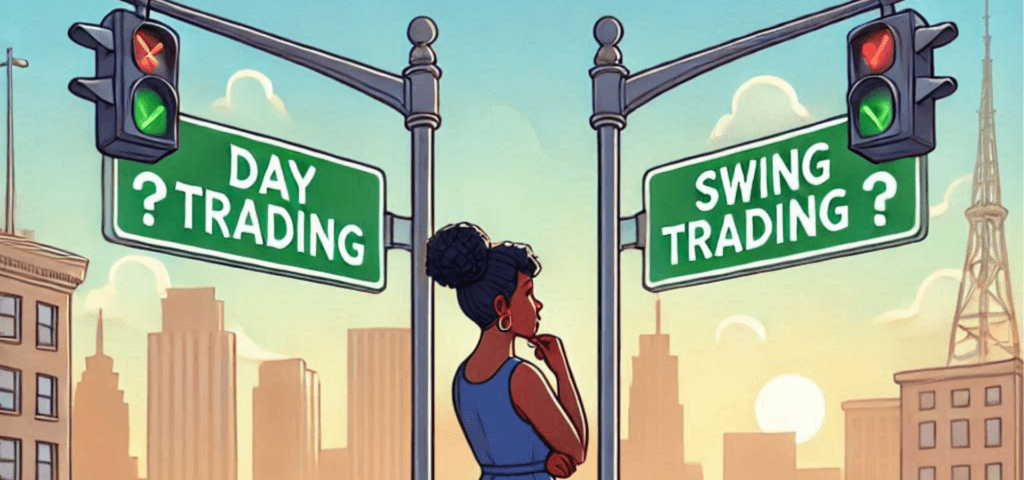
When it comes to diving into the world of stock trading, you might find yourself standing at a crossroads: day trading or swing trading. These are the two titans of trading styles you’ll often hear about. But before picking sides, it’s crucial to get a solid grip on what each really means.
Day trading, for starters, is all about the hustle. Traders buy and sell financial instruments like stocks and currencies within the same trading day. Think rapid trades, intense focus, and an eye constantly on the screen. It’s kind of like a sprint where each second can pivot your fortunes.
Swing trading, on the other hand, is a little more laid-back, if you will. It involves holding positions for several days or even weeks to capitalize on expected upward or downward market shifts. It’s about catching those swings – hence the name – and riding them for a while. It’s more marathon than sprint, giving decisions a bit more room to breathe.
So, why do these trading styles even exist? They’re developed from the unique needs and opportunities offered by different market niches. Day traders might hang out in markets with volatile, quick-moving stocks or forex trades. Swing traders might lean towards markets where there’s steadiness and well-defined patterns over longer periods.
Before you find yourself signing up for either, here’s what you’ve got to chew over. Ask yourself some key questions:
- How much time can you commit daily?
- How comfortable are you with quick decisions?
- What’s your financial goal – to earn daily or over a stretch of days?
These considerations set the stage for your journey in trading, nudging you a step closer to choosing the right path.
Day Trading: Speed, Intensity, and Opportunity
Day trading’s like stepping onto a rollercoaster with all its dizzying rushes. It’s fast-paced and requires more than just keen market awareness; you’re glued to your screen, tracking the smallest market movements to grab profitable opportunities. I mean, that’s the excitement of it all, but you better buckle up and hang on tight.
When you’re in the day trading seat, think quick decision-making. Seconds matter on these fronts, and having an edge often means leaning heavily on technical analysis and real-time data. You’re studying patterns, charts, and signals almost like a modern-day detective, searching for those critical clues that offer the next big move.

But let’s not get it twisted. Day trading isn’t just about winning big; it’s about managing those inevitable slumps too. Sure, there’s potential for hefty profits, but you also need nifty risk management skills to minimize losses. This style’s high stakes mean having a solid plan B ready to jump into action whenever necessary.
What about the risks, you ask? Day traders dance on the fine line between gain and loss, riding volatility waves that can flip in the blink of an eye. So it’s not just for anyone; it demands grit and the ability to maintain a level head under pressure. This route promises thrilling opportunities, yet it’s equally unforgiving if you don’t play your cards smart.
Bottom line, if you’ve got a knack for adrenaline-fueled environments and can handle the heat while making split-second calls, day trading might just be your thing. Just keep those wits sharp and strategies sharper, and you’re set for an unforgettable ride.
Swing Trading: Patience, Strategy, and Profit Potential
Swing trading offers a different vibe altogether. This approach invites you to settle in and let your trades marinate over several days or weeks, giving you room to think over every move and strategize without having to watch the clock tick every second.
It’s not just about sitting back, though. Swing traders dive into a deeper analysis of market trends, often relying on both technical and fundamental analysis to forecast price movements. This broader perspective allows for a smoother decision-making process. You’re looking at the bigger picture, not just the here and now.
Managing risks in swing trading involves selectively choosing entry and exit points. Trades aren’t created on instinct but through patient observation of market trends and patterns. Profit potential is real if you match that patience with smart, tactical choices.
Swing trading is also highly strategic, offering a mix of excitement and essays-on-patience. Compared to day trading’s breakneck speed, this style benefits those who appreciate calculated moves and don’t mind waiting for well-timed decisions to bear fruit.
But don’t mistake it for easy money. There are challenges. It requires a good chunk of research and market knowledge. You have to be okay with occasionally sleeping on your trades, knowing markets might shift overnight.
If patience is your game and a well-structured plan your playbook, then swing trading holds intriguing possibilities. It’s a subtle dance with the market that, when done right, can yield satisfying results.
Key Differences: Making the Right Choice for Your Lifestyle
Picking between day trading and swing trading boils down to aligning your trading style with your daily life and personal preferences. It’s not just about market tactics but where and how you want to spend your time.

Day trading demands a bigger chunk of your day and a near-constant presence at the trading desk. If you’re someone who thrives in high-pressure environments and loves the buzz of rapid action, this could be your match. The fast-paced style will likely influence how you shape your daily schedule, needing those hours dedicated solely to trading.
Swing trading, though less intense in terms of screen time, requires extended focus over days, maybe even weeks. You’re engaging with less frequency but possibly more depth, making it a great choice for those who have other commitments or prefer not to be glued to their screen. It allows for a well-paced work-life-trade balance.
Knowing your risk tolerance plays a key role, too. With its hourly swings, day trading involves more direct risks and rewards; however, swing trading carries its own set of risks, especially with overnight market changes.
Financial goals and personality traits also weigh in heavy. Are you aiming for daily gains or steady profit over time? Do you trust in gut decisions, or do you lean towards strategic patience? These questions help steer your trading path.
In the end, the choice reflects what fits best with your ambitions, lifestyle, and how you handle the market temperament. Both have their virtues and challenges—it’s about knowing which one complements you and your goals.

Loved how you broke this down! Day trading’s all gas, no brakes—great for folks who thrive on speed and data. But swing trading? That’s more my tempo—calculated, strategic, and still thrilling. I’m curious—do you think one has a lower learning curve for beginners, or is it all about mindset and time commitment from the jump?
The learning curve in trading isn’t inherently easier or harder—it depends on your mindset and time commitment. A disciplined, patient approach and consistent effort are key. Beginners may find long-term investing less overwhelming than day trading, but success in any style comes from embracing the process and staying committed.